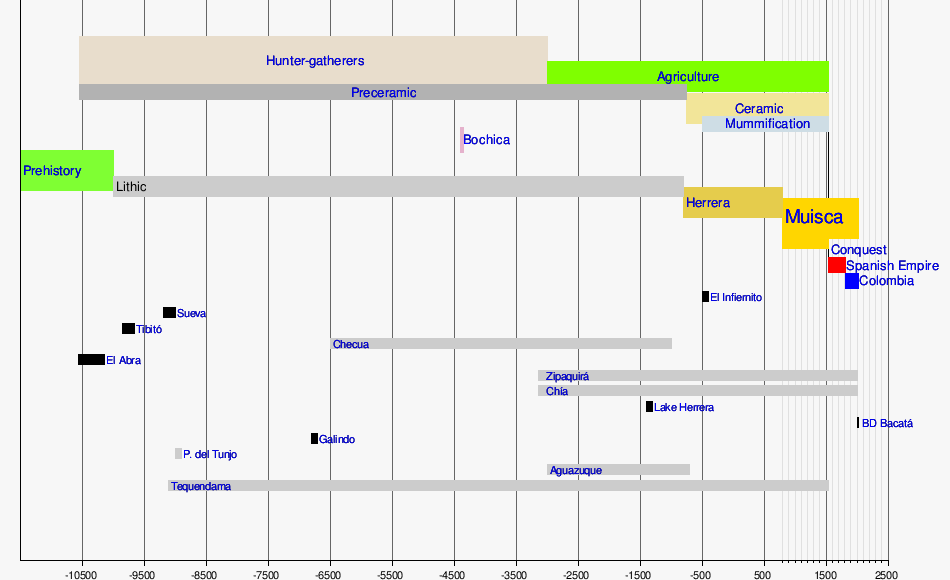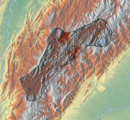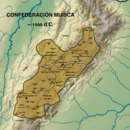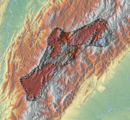Tibitó
| Location | Tocancipá, Cundinamarca |
|---|---|
| Region | Bogotá savanna Altiplano Cundiboyacense |
| Coordinates | 4°59′08.4″N 73°58′58.4″W / 4.985667°N 73.982889°W |
| Altitude | 2,555 m (8,383 ft)[1] |
| Type | Rock shelter |
| Part of | Pre-Muisca sites |
| History | |
| Material | Stone & bone tools Carbon |
| Founded | ~11,850 BP |
| Periods | Prehistory-Herrera |
| Cultures | Preceramic-Herrera |
| Site notes | |
| Archaeologists | Gonzalo Correal Urrego[2][3] |
Tibitó is the second-oldest dated
Principal research at Tibitó was carried out by Colombian
Background
The Altiplano Cundiboyacense, and its southeastern flat portion the
During the latest Pleistocene and early Holocene, the first humans arrived on the
| Timeline of inhabitation of the Altiplano Cundiboyacense, Colombia | |
 |
   |
Description

Radiocarbon dating of a deeper lacustrine clay in the sequence of Tibitó revealed the site was in a lake environment around 52,000 years BP.
At Tibitó remains of the extinct
In the vicinity of Tibitó, rock art has been discovered.[4]
See also
References
- ^ Google Maps Elevation Finder
- ^ a b Correal Urrego, 1990
- ^ a b Cooke, 1988, p.180
- ^ ICANH
- ^ Hoyos et al., 2015, p.265
- ^ Zonneveld, 1968, p.205
- ^ Vogel & Lerman, 1969, p.358
- ^ Villarroel et al., 2001, p.79
- ^ Scott & Meyers, 1994, p.390
- ^ Prado et al., 2003, p.353
- ^ a b Correal Urrego, 1990, p.76
- ^ Dillehay, 1999, p.208
- ^ Correal Urrego, 1990, p.74
- ^ Gnecco & Aceituno, 2004, p.155
- ^ Correal Urrego, 1990, p.77
Bibliography
- Cooke, Richard. 1998. Human settlement of Central America and northernmost South America (14,000-8000 BP). Quaternary International 49/50. 177–190. .
- Correal Urrego, Gonzalo. 1990. Evidencias culturales durante el Pleistocene y Holoceno de Colombia - Cultural evidences during the Pleistocene and Holocene of Colombia. Revista de Arqueología Americana 1. 69–89. Accessed 2016-07-08.
- Evolutionary Anthropology_. 206–216. .
- Gnecco, Cristóbal, and Javier Aceituno. 2004. Poblamiento temprano y espacios antropogénicos en el norte de Suramérica - Early peopling and anthropogenic spaces in the northern South America. Complutum 15. 151–164. .
- Montes, Natalia; O. Monsalve; G.W. Berger; J.L. Antinao; H. Giraldo; C. Silva; G. Ojeda; G. Bayona, and J. Escobar. 2015. A climatic trigger for catastrophic Pleistocene–Holocene debris flows in the Eastern Andean Cordillera of Colombia. Journal of Quaternary Science 30(3). 258–270. .
- Prado, José Luis; María Teresa Alberdi; Begoña Sánchez, and Beatríz Azanza. 2003. Diversity of the Pleistocene Gomphotheres (Gomphotheriidae, Proboscidea) from South America. Deinsea 9. 347–363. .
- Scott, David A., and Pieter Meyers. 1994. Archaeometry of Pre-Columbian sites and artifacts, 1–437. The Getty Conservation Institute.
- Villarroel, Carlos; Ana Elena Concha, and Carlos Macía. 2001. El Lago Pleistoceno de Soatá (Boyacá, Colombia): Consideraciones estratigráficas, paleontológicas y paleoecológicas. Geología Colombiana 26. 79–93. .
- Vogel, J.C., and J.C Lerman. 1969. Groningen Radiocarbon Dates VIII. Radiocarbon II(2). 351–390. .
- Zonneveld, Jan Isaak Samuel. 1968. Quaternary climatic changes in the Caribbean and N. South America, 203–208.
Further reading
- Correal Urrego, Gonzalo. 2002. Evidencias Culturales Pleistocénicas y del Temprano Holoceno en la Cordillera Oriental de Colombia: Periodización Tentativa - Cultural evidences of the Pleistocene and Early Holocene in the Eastern Ranges of Colombia: tentative timing, 63–73. Accessed 2016-07-08.
- Correal Urrego, Gonzalo. 1990. Aguazuque: Evidence of hunter-gatherers and growers on the high plains of the Eastern Ranges, 1-316. Banco de la República: Fundación de Investigaciones Arqueológicas Nacionales. Accessed 2016-07-08.
- Groot de Mahecha, Ana María. 1992. Checua: Una secuencia cultural entre 8500 y 3000 años antes del presente - Checua: a cultural sequence between 8500 and 3000 years before present, 1-95. Banco de la República. Accessed 2016-07-08.
- Hammen, Thomas van der; Gonzalo Correal Urrego, and Gert Jaap van Klinken. 1990. Isótopos estables y dieta del hombre prehistórico en la sabana de Bogotá - Stable isotopes and diet of the prehistoric man on the Bogotá savanna. Boletín de arqueología 2. 3-10. .
- Hammen, Thomas van der, and Gonzalo Correal Urrego. 2003. Supervivencia de mastodontes, megaterios y presencia del hombre en el Valle del Magdalena (Colombia) entre 6000 y 5000 A.P. - Survival of mastodonts, megatheriums and the presence of man in the Magdalena Valley (Colombia) between 6000 and 5000 years BP. Rev. Acad. Colomb. Cienc. 27. 159-164. Accessed 2016-07-08.



